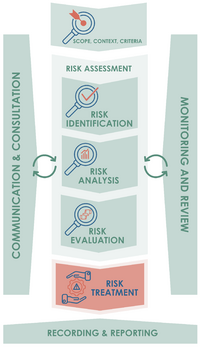Managing threats and opportunities in risk treatment
(→The risk management process) |
(→The risk management process) |
||
| Line 10: | Line 10: | ||
=== The risk management process === | === The risk management process === | ||
| − | + | [[File:The_risk_management_process.png|right|thumb|200px|Figure 1: Risk Management Process <ref name=ISO31000_2018> Danish Standards Association (2018), DS/ISO 31000:2018, Risk management - Guidelines, Retrieved from https://sd.ds.dk/Viewer/Standard?ProjectNr=M296412&Status=60.60&VariantID=41&Page=0 </ref>]] | |
| − | Risk management is a process that works to manage risks to ensure that it cause the least impact in the project. The process involves a ''"systematic application of policies, procedures and practices to the activities of communicating and consulting, establishing the context and assessiong, treating, monitoring, reviewing, recording and reporting risk"''<ref name=ISO31000_2018/>. | + | Risk management is a process that works to manage risks to ensure that it cause the least impact in the project. The process involves a ''"systematic application of policies, procedures and practices to the activities of communicating and consulting, establishing the context and assessiong, treating, monitoring, reviewing, recording and reporting risk"'' <ref name=ISO31000_2018/>. |
ref iso 31000_2018: | ref iso 31000_2018: | ||
| + | <ref name=ISO31000_2018/> | ||
| + | |||
<ref name=ISO31000_2018> Danish Standards Association (2018), DS/ISO 31000:2018, Risk management - Guidelines, Retrieved from https://sd.ds.dk/Viewer/Standard?ProjectNr=M296412&Status=60.60&VariantID=41&Page=0 </ref> | <ref name=ISO31000_2018> Danish Standards Association (2018), DS/ISO 31000:2018, Risk management - Guidelines, Retrieved from https://sd.ds.dk/Viewer/Standard?ProjectNr=M296412&Status=60.60&VariantID=41&Page=0 </ref> | ||
Revision as of 09:41, 14 February 2023
Developed by Theis Rosenkvist Sørensen
Risk management is the final stage in the risk management process. It is used to control and monitor the uncertainties during the project. When managing a project, uncertainties are one of the most important factors to control in order to achieve a successful project. Uncertainties occur when certain events in a project are unpredictable and it will only be possible to guess about a future event. Risk management is used to identify risks in the project that help maintain stability and used to prevent unforeseen events that can be cost, resource or time consuming. By using risk management, it is possible to ensure that the project team achieves the goals they are solving by not encountering many unpredictable obstacles during the project.
The risk management process is a five-step monitoring process that establishes context, identifies, analyzes, evaluates and addresses potential risks over the life of a project. By managing the project using responses to threats and opportunities, it becomes possible to minimize the impact of the risk. If this can be done in a successful way, better risk management is achieved and it will thus be possible to reduce the impact of the uncertainties in the project. By using Rumsfeld's (un)known-unknowns, it becomes possible to reduce the risk by establishing precautions that can prevent or reduce the uncertainties from arising.
When working with risk treatment, there are some limitations. One of the crucial limitations is the lack of knowledge sharing. The lack of knowledge sharing leads to a greater amount of uncertainties that could have been prevented. However, not all uncertainties can be prevented and even perfectly planned projects have their limitations. By having a greater amount of expertise, a higher level of risk treatment can be performed and will minimize the risk by identifying crucial uncertainties in the project.
Contents |
Introduction
The risk management process

Risk management is a process that works to manage risks to ensure that it cause the least impact in the project. The process involves a "systematic application of policies, procedures and practices to the activities of communicating and consulting, establishing the context and assessiong, treating, monitoring, reviewing, recording and reporting risk" [1].
ref iso 31000_2018: [1]
ref PMI:
Project Management Institute, Inc. (PMI). (2021). A Guide to the Project Management Body of Knowledge (PMBOK ® Guide) – 7th Edition and The Standard for Project Management - 2.8.5.2 Opportunities. (pp. 122-125). Project Management Institute, Inc. (PMI). Retrieved from https://app.knovel.com/hotlink/pdf/id:kt012LZJB1/guide-project-management/opportunities
Donald Rumfeld's matrix
abc
Risk treatment
abc
Extra?
abc
NOTES:
When reacting to threats, ARTA (Avoid, Reduce, Transfer, Accept) can be used as an approach to the Risk Management Process. The goal is to reduce the impact to zero by either avoiding, reducing or transferring the risks.
Some of the response strategies to threats and Opportunities will also be highlighted in this article
By using risk management, it is possible to ensure that the project team achieves the goals they are solving
Risk management is a five-step monitoring process that establishes context, identifies, analyzes, evaluates and addresses potential risks over the life of a project.
Risk can be either threats or opportunities...
Risk treatment is a way to manage and act on the identified risks.
(CONTENT)
This is a page will be elaborated on the following topics:
- Managing threats and opportunities in risk treatment introduction (known knowns?, risk management, risk treatment)
- Risk management process (the 5 stages in the risk management process)
- Responses to threats and opportunities
- Discussion and conclusion
- References
NOTES FOR ABSTRACT:
The goal is to take procortions for the uncertainties and reduce the impact it can we on the project. This can be done by...
In project management there is a lot of uncertainties we need to prepare and take procortions for. By doing this it will be possible to prevent unknown factors that can occure. mannaging thorugout the whole projct.
The 5 steps in risk management
responding to threats - ARTA
Responding to opportunities
Risk Management Process
abc
References
- ↑ 1.0 1.1 1.2 1.3 Danish Standards Association (2018), DS/ISO 31000:2018, Risk management - Guidelines, Retrieved from https://sd.ds.dk/Viewer/Standard?ProjectNr=M296412&Status=60.60&VariantID=41&Page=0
Made by Theis Sørensen (s195768)